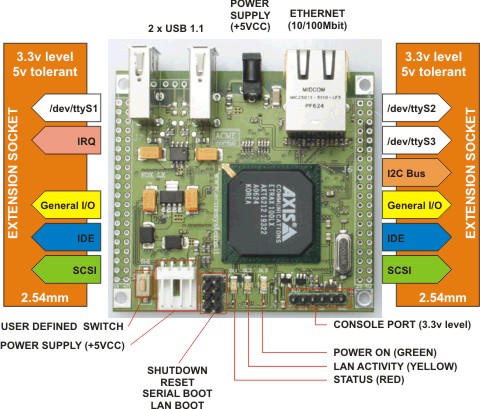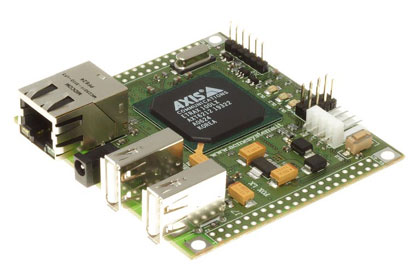
|
FOX
Board "FOX Board is a ready to use and low cost Linux embedded board designed to reduce the time to market of your embedded projects." FOX Board is manufactured by ACME Systems and runs a real Linux operating system (not a uC Linux) on an ETRAX 100LX microprocessor, a 100MIPS RISC CPU made by Axis (http://developer.axis.com). |
|
||||||||||||||||||||||||||||||||||
Hardware Features
|
|||||||||||||||||||||||||||||||||||
Extension Sockets
On either side of the Fox board it is possible to solder two 20x2 pin strip connectors step 2.54mm (0.1") to put the FOX Board over an application board or move signals to another board using normal 40 pin flat cables.
A lot of peripherals can be connected to the FOX Board using these signals and hardware adapters when needed:
- Up to 2 parallel ports or 1 wide parallel port (**)
- Up to 4 IDE ports (8 peripherals) (**)
- Up to 2 SCSI ports or 1 wide SCSI port (**)
- I2C bus
- Up to 48 general purpose I/O (**)
- Up to 4 asynch serial ports (**) (***)

Extension socket lines
Notes
All the signal lines on the extension sockets need mechanical and/or electrical
adapters to be used.
(*) With no usb or other devices connected
(**) Not all the signals on the extension sockets can be used at the same time.
The peripheral signals configuration depends on Kernel setup and line
assignments.
(***) The serial ports on Axis are four: 1 asynchronous port is already used as
console (/dev/ttyS0) and it is not available on the extension sockets but only
on the console connector J10; 1 other port (/dev/ttyS1) is in common with the
USB1 port, the other 2 ports are completely available (/dev/tty2 and
/dev/tty3). One of these can be configured also as RS485 or synchronous.
